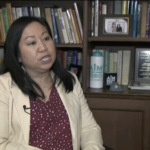By Andrew Malekoff
Members of a Wisconsin middle school basketball team are being lauded as heroes, and rightfully so. When the boys noticed some bullies making fun of one of their cheerleaders—a 14-year-old girl named Desiree who has Down’s Syndrome—they took action, walking over to the bleachers and telling the offenders to cut it out. As one of the boys told reporters, “They were pointing and laughing at her from the stands. It’s not funny to make fun of somebody by the way they look or act.” Another said, “This is not a one-time thing. You always have to stick up for kids that are bullied. It’s the right thing to do.”
Another group in New York City, Teen Pact, has taken steps to combat cyberbullying by producing public service announcements that are being used nationwide. One PSA depicts a boy texting an affectionate message about a classmate. His friends then pass it on and when it goes viral he becomes the target of unrelenting teasing and taunting. The PSA message is: “It’s not funny anymore, don’t be an accidental bully.”
Just how many kids are being tormented, either online, in school or both? Recent studies report some startling statistics:
- 83 percent of girls and 79 percent of boys report being bullied either in school or online.
- 75 percent of school shootings have been linked to harassment and bullying against the shooter.
- About 160,000 teens skip school every day because they are bullied, and 1 in 10 teens drops out of school due to repeated bullying.
- Kids who are bullies as young adults continue the trend of abuse and violence into adulthood. By the age of 30, about 40 percent of boys identified as bullies in middle and high school had been arrested three or more times.
The most frequent targets are kids seen as “different”—gay or transgender youth, those with special needs or who are overweight—but no kid is immune from being a victim.
While bullying isn’t a new phenomenon, cyberspace obliterates any sense of sanctuary that children once found when they were away from school and in their own homes.
One social media app that’s particularly alarming is Yik Yak, which allows users to send out posts—known as “yaks” — that can be seen by anyone within a 1.5-mile radius. What makes it worse than most other social media forums kids are using is the fact that the posters are anonymous. A user can “yak” out anything they want without fear of being identified. Perfectly acceptable posts: “Jane is an ugly cow,” “John is a fag,” and much more that would be unprintable in this newspaper. It’s devastating to imagine the damage this type of abuse can have on a child or teen.
Laws such as the Dignity for All Students Act , which took effect in July 2012, seeks to provide students with a safe and supportive environment free from discrimination, intimidation, taunting, harassment and bullying on school property, buses or at a school function.
The passage of the dignity act provides an opportunity for parents to talk to their children about how to protect themselves from bullying and offers them a context to discuss how to be sensitive to others who are different. This is, of course, providing that parents are able to engage their children in an accepting and nonjudgmental manner that opens communication.
But laws like the dignity act aren’t enough to tackle what is a social problem. No amount of legislation and no penalties for intimidating schoolyard behavior can guarantee that children will be safe at all times whether inside or outside of school.
These laws must be complemented by support at home, pro-social bonds among neighbors and consistent community standards against bullying, bias and harassment, including in cyberspace. Otherwise, the legislation will be little more than a paper tiger, another layer of bureaucracy with limited influence in the real world.
Additional Information: View Website Link













